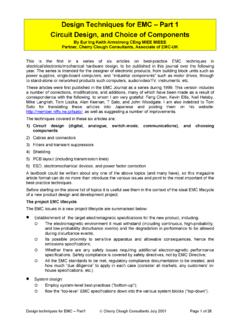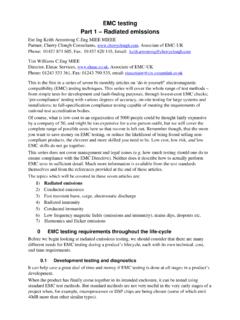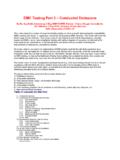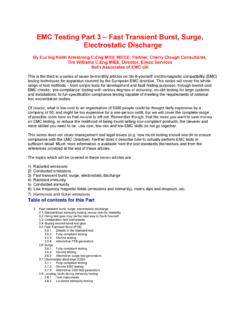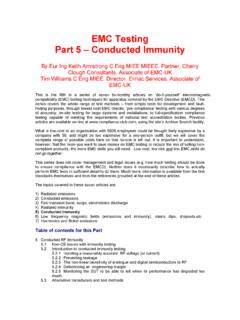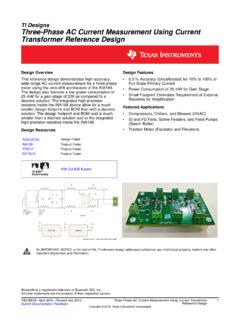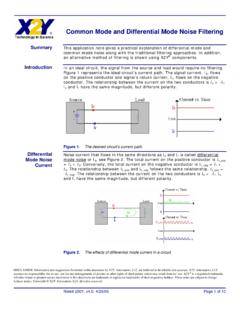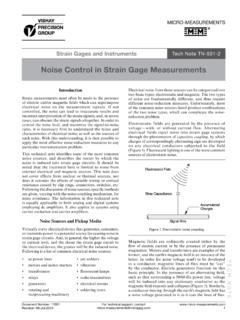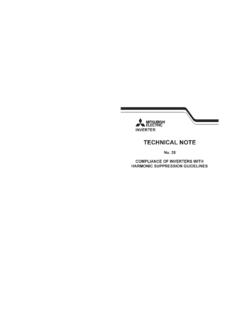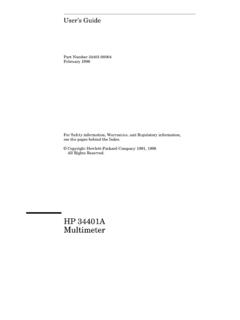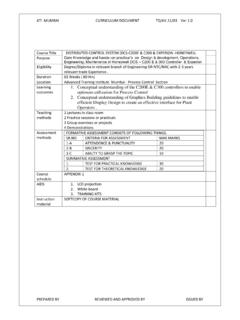Transcription of EMC Testing Part 6 - compliance-club.com
1 EMC Testing part 6 Low-frequency magnetic fields (emissions and immunity);mains dips, dropouts, interruptions, sags, brownouts and swells By Eur Ing Keith Armstrong MIEE MIEEE, Partner, Cherry Clough Consultants, Associate of EMC-UK Tim Williams MIEE, Director, Elmac Services, Associate of EMC-UK This is the sixth in a series of seven bi-monthly articles on do-it-yourself electromagnetic compatibility (EMC) Testing techniques for apparatus covered by the EMC Directive (EMCD). This series covers the whole range of test methods from simple tests for development and fault-finding purposes, through lowest-cost EMC checks; pre-compliance Testing with various degrees of accuracy; on-site Testing for large systems and installations; to full-specification compliance Testing capable of meeting the requirements of national test accreditation bodies.
2 Previous articles are available on-line at , using the site s Archive Search facility. What is low-cost to an organisation with 5000 employees could be thought fairly expensive by a company with 50, and might be too expensive for a one-person outfit, but we will cover the complete range of possible costs here so that no-one is left out. It is important to understand, however, that the more you want to save money on EMC Testing or reduce the risk of selling non-compliant products, the more EMC skills you will need. Low cost, low risk and low EMC skills do not go together. This series does not cover management and legal issues ( how much Testing should be done to ensure compliance with the EMCD). Neither does it necessarily describe how to actually perform EMC tests in sufficient detail to do them.
3 Much more information is available from the test standards themselves and from the references provided at the end of these articles. The topics covered in these seven articles are: 1) Radiated emissions 2) Conducted emissions 3) Fast transient burst, surge, electrostatic discharge 4) Radiated immunity 5) Conducted immunity 6) Low frequency magnetic fields emissions and immunity; plus mains dips, dropouts, interruptions, sags, brownouts and swells 7) Harmonics and flicker emissions Table of contents for this part 6 Low frequency magnetic fields emissions and immunity; plus mains dips, dropouts, interruptions, sags, brownouts and swells 50Hz-50kHz magnetic field emissions Fully-compliant LF magnetic field emissions tests Low-cost test methods for LF magnetic emissions On-site Testing LF magnetic emissions magnetic fields and the environment 50Hz magnetic field immunity Fully compliant 50Hz magnetic field immunity tests Low-cost Testing of 50Hz magnetic field immunity On-site Testing of 50Hz magnetic field immunity 50Hz pulsed magnetic field immunity 50Hz-10kHz magnetic field immunity Fully compliant 50Hz-10kHz magnetic field immunity tests Low-cost Testing for 50Hz-10kHz magnetic field immunity On-site Testing for 50Hz-10kHz magnetic field immunity AC mains supply dips.
4 Dropouts and interruptions Full-compliance Testing of dips and short interruptions A home-made dips, dropouts, and interruptions tester On-site Testing of dips and short interruptions AC mains supply sags/brownouts and swells Full compliance voltage variation (sags only) Testing Swell Testing A home-made sags and swell tester On-site Testing of sags and swells Full-compliance Testing for three-phase equipment Correlating alternative test methods References 6 Low frequency magnetic fields emissions and immunity; plus mains dips, dropouts, interruptions, sags, brownouts and swells part 0 of this series [1] described the various types of EMC tests that could be carried out, including: Development Testing and diagnostics (to save time and money) Pre-compliance Testing (to save time and money) Full compliance Testing Troubleshooting to quickly identify and fix problems with compliance tests, or with interference in the field QA Testing (to ensure continuing compliance in volume manufacture) Testing of changes and variants (to ensure continuing compliance).
5 And part 0 also described how to get the best value when using a third-party test laboratory [1]. This series focuses on Testing to the EN standards for typical domestic / commercial / industrial environments. Other kinds of immunity tests may be required for automotive, aerospace, space, rail, marine and military environments. Over the years these, and other industries, have often developed their own immunity test standards based on their own particular kinds of disturbances, usually for reliability reasons. See part 4 of this series [2] for more detail on the following important issues for immunity Testing : Saving costs by early EMC Testing (section ). Immunity Testing for reliability and functional safety (section ). The basic EN test methods described here are identical to the basic IEC test methods ( EN 61000-4-8 = IEC 61000-4-8), so this article may also be of use where non-EU EMC requirements apply.
6 Safety Note: Some of the tests described in this part involve electrical hazards, particularly those associated with the mains supply, and all appropriate safety precautions must be taken. If you have any doubts about the exact safety precautions you should be taking, ask a competent person. EN 61010-1:2001 is often the most relevant safety standard in test and measurement situations. You may even need to go outside your own organisation to find a suitably competent person if so a local Health and Safety at Work inspector or LVD Notified Body should be able to recommend someone. Health and Safety inspectors can be found in your local telephone directory or directory enquiries, while a list of LVD Notified Bodies and their contact details can be found at the LVD s homepage: 50Hz-50kHz magnetic field emissions There are no standards in the EN 61000-4-x series covering the measurement of magnetic field emissions under 150kHz, and most harmonised EMC emissions standards don t include any requirements to measure such magnetic fields.
7 However, LF magnetic field emissions tests might be a useful (or even necessary) part of some Technical Construction Files or in design/development or troubleshooting. When one item of equipment is in close proximity to another, LF magnetic fields can cause interference. This is especially a problem for CRT image wobble , but also for baseband circuits such as instrumentation, video and audio, whose circuits and cables can couple with the magnetic fields and suffer significant amounts of crosstalk in some situations. EN 55103-1 [3] the so-called PAVI standard (short for professional audio, video, and lighting industry) does include an emission test for LF magnetic fields from 50Hz to 50kHz. Professional equipment such as this is often racked or stacked very close to other equipment and magnetic field coupling can be a real concern.
8 The companion immunity standard to EN 55103-1 is EN 55103-2 [5] and this includes a test for immunity to LF magnetic fields from 50Hz to 10kHz (see below). Meeting the magnetic field requirements of this pair of standards will help ensure freedom from LF magnetic field crosstalk for items of equipment that will be located close to each other. The magnetic field test method in [3] is based on the USA s MIL-STD-462D method RE101, which covers 30Hz to 100kHz. This is similar, if not identical, to the UK s DEF STAN 59-41 Method DRE02 which covers 20Hz to 50kHz. Fully-compliant LF magnetic field emissions tests Because there is no basic measurement method standard in the EN 61000-4-x series to call upon for these LF field tests, [3] describes the test method to be used in detail in its Annex A, which only has two pages.
9 The test is very easy to perform and does not require a special environment, such as a shielded room. Figure 6A shows the construction details for the loop sensor to be used for the tests. The output from the loop sensor is connected to an audio frequency spectrum analyser with an input impedance greater than 10k and a resolution bandwidth of 10Hz 20% and measures the voltage V (rms or quasi-peak). The measured field (H) in Amps/metre is given by the conversion factor (transducer factor) H = 253V/f (when V is in millivolts and f is in Hz). Calibration of the loop sensor is not necessary when it is constructed according to Figure 6A and the above conversion factor is used. Prior to the test the test environment is scanned with the loop sensor to check that the ambient fields are less than one-quarter of the limits to be measured to, with the equipment under test (EUT) switched off.
10 This is the only requirement for the test environment although it is a sensible precaution to ensure that any metal objects are at least three times the test distance away from the EUT. Large steel objects should ideally be five times the test distance away. If the local magnetic fields are too high, move the test location somewhere quieter (see below). During the test the EUT is operated in its normal way with its normal signals, set up so as to cause the worst magnetic emissions. For example, an audio power amplifier would be operated at full output power into its lowest-rated output impedance to maximise its output and power supply currents. Where signals can range over a band of frequencies standard Testing waveforms should be used [3] specifies pink noise for audio equipment and colour bars for video equipment.
